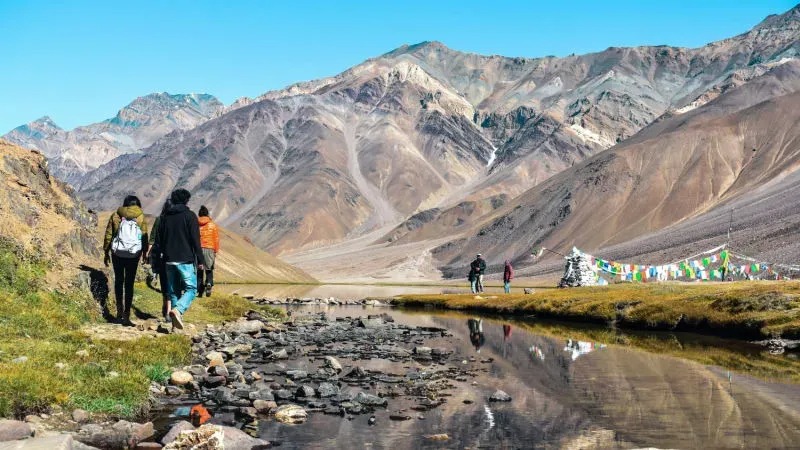The Himalayan region of India is a dream destination for adventure enthusiasts and nature lovers alike. Among the myriad options, a journey that spans from Spiti to Leh offers a unique blend of serene landscapes, ancient monasteries, and thrilling experiences. This multi-region adventure takes you through the remote Spiti Valley in Himachal Pradesh to the stark, high-altitude deserts of Leh in Ladakh, creating an unforgettable experience. Here’s how to plan the perfect adventure from Spiti to Leh.
Table of Contents
ToggleUnderstanding the Route
The journey from Spiti to Leh is not just about traveling from one destination to another; it’s about the experiences along the way. The route is challenging and demands careful planning, but the rewards are more than worth it. The journey typically starts in Manali, from where you enter the Spiti Valley via the Rohtang Pass and Kunzum La. After exploring Spiti, you continue towards Leh, crossing some of the highest motorable passes in the world, such as Baralacha La, Lachulung La, and Tanglang La. This adventure is perfect for those seeking a blend of spiritual, cultural, and adrenaline-pumping experiences.
Choosing the Right Time to Travel
Timing is crucial when planning your journey from Spiti to Leh. The roads connecting these remote regions are only accessible from late May to early October due to heavy snowfall in the winter months. July to September is considered the best time to undertake this adventure. The weather is pleasant, and the roads are usually in better condition. Additionally, this period allows you to witness the stark contrast between the lush greenery of Spiti and the barren yet mesmerizing landscape of Leh.
If you’re looking to make the most of your trip, consider opting for one of the Spiti Valley holiday packages available during this peak season. These packages often include guided tours, accommodation, and transportation, ensuring that your journey through the rugged terrain is as smooth as possible.
Planning Your Itinerary
A well-planned itinerary is key to enjoying your Spiti to Leh adventure. Here’s a suggested itinerary that covers the highlights of both regions:
Day 1-2: Manali to Kaza (Spiti Valley)
Begin your journey in Manali, where you can spend a day acclimatizing to the altitude. From Manali, travel to Kaza, the capital of Spiti Valley, crossing the Rohtang Pass and Kunzum La en route. The drive offers stunning views of snow-capped peaks, lush valleys, and the dramatic Spiti River.
Day 3-4: Exploring Spiti Valley
Spend the next two days exploring Spiti Valley. Visit the Key Monastery, the largest and most iconic monastery in Spiti, perched on a hilltop overlooking the valley. Don’t miss the nearby Kibber village, one of the highest inhabited villages in the world. Tabo Monastery, known for its ancient murals and sculptures, is another must-visit site. These attractions are often included in Spiti Valley holiday packages, providing a comprehensive tour of the region’s cultural and spiritual heritage.
Day 5: Kaza to Sarchu
From Kaza, start your journey towards Leh, with an overnight stop at Sarchu, a popular camping site located at 14,000 feet. The route from Kaza to Sarchu takes you through some of the most remote and rugged terrains in the Himalayas, including the stunning Baralacha La pass.
Day 6: Sarchu to Leh
Continue your journey towards Leh, crossing more high-altitude passes such as Lachulung La and Tanglang La. The dramatic change in landscape as you approach Leh is breathtaking, with the arid desert giving way to the lush Indus Valley. Once you reach Leh, take some time to rest and acclimatize, as the altitude here is even higher than in Spiti.
Day 7-8: Exploring Leh and its Surroundings
Leh is a vibrant town with a rich cultural heritage. Spend your time exploring the local markets, visiting the Leh Palace, and taking in the panoramic views from the Shanti Stupa. Leh is also home to several ancient monasteries, such as Hemis, Thiksey, and Diskit, each offering a unique glimpse into the region’s Buddhist traditions.
Day 9-10: Excursion to Nubra Valley or Pangong Lake
No trip to Leh is complete without a visit to either Nubra Valley or Pangong Lake. Nubra Valley, accessible via the world’s highest motorable road at Khardung La, is known for its stunning sand dunes and the double-humped Bactrian camels. Alternatively, you can head to Pangong Lake, one of the most beautiful high-altitude lakes in the world, famous for its changing colors and crystal-clear waters.
Essential Tips for the Journey
- Acclimatization: The high altitudes in both Spiti and Leh require proper acclimatization to avoid altitude sickness. It’s important to take things slow, especially in the first few days of your journey. Hydration is key, so drink plenty of water and avoid strenuous activities until you’ve adjusted to the altitude.
- Permits: Traveling in these regions often requires obtaining permits. For Spiti Valley, you’ll need an Inner Line Permit if you plan to visit areas close to the Indo-Tibetan border, such as Tabo or Komic. Similarly, in Leh, permits are required for visiting Nubra Valley, Pangong Lake, and other restricted areas. These permits can usually be arranged through your travel agency or obtained locally.
- Packing Essentials: Pack light but ensure you have all the essentials. Warm clothing is a must, as temperatures can drop significantly, even in the summer. A good pair of trekking shoes, sunscreen, and a basic medical kit are also necessary. Additionally, carrying snacks and water is advisable, as facilities can be sparse along the route.
- Transportation: While some travelers prefer to drive their own vehicles, many opt for hired jeeps or join guided tours that offer reliable transportation. Roads in this region can be treacherous, and local drivers are well-versed in navigating these challenging conditions.
Embracing the Adventure
The journey from Spiti to Leh is as much about the experience as it is about the destination. Each region has its unique charm—Spiti’s secluded monasteries and picturesque villages contrast beautifully with Leh’s stark desert landscape and vibrant culture. Along the way, you’ll encounter friendly locals, witness ancient traditions, and immerse yourself in the tranquil beauty of the Himalayas.
Whether you’re exploring the labyrinthine lanes of Leh’s old town or marveling at the stunning vistas of Spiti Valley, this multi-region adventure promises memories that will last a lifetime. By carefully planning your itinerary and taking advantage of the Spiti Valley holiday packages and other services available, you can ensure that your journey from Spiti to Leh is as smooth and enjoyable as possible.
In conclusion, a multi-region adventure from Spiti to Leh is an opportunity to explore some of the most remote and breathtaking regions of the Himalayas. With the right planning and a sense of adventure, you can embark on a journey that offers not just stunning landscapes, but also a deep connection with the culture and spirituality of this incredible region.




